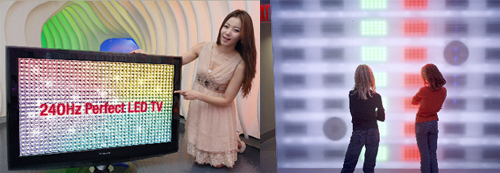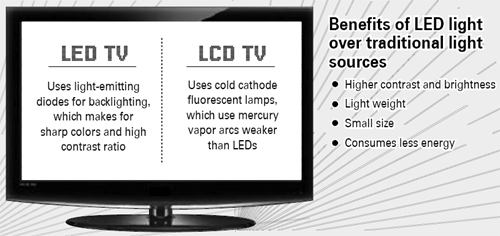So what exactly are LEDs?

Left: Samsung launched the PAVV 600/7000 series in March this year. Right: Visitors watch the lights at the International LED Expo last year in Goyang, Gyeonggi. Provided by the companies
The sherbet colors featured in the commercial represent the main selling point of the 3G phone - a screen featuring LEDs, or light-emitting diodes, on its cover.
Leading LEDs
We can’t go anywhere in Seoul these days without coming in contact with a product boasting an LED lighting function. Numerous third-generation mobile phones, the newest television sets and notebook computers include “LED” as the punch line for promotion.

Thanks to these benefits, the global LED market is expected to blossom in the near future. According to Korea Photonics Technology Institute, the global LED market was worth around $21.4 billion last year and is expected to grow nearly three times that amount to around $54.6 billion by 2012. In Korea alone, the LED market is worth 2.43 trillion won ($1.96 billion). However, by next year, it is forecast to grow to around 3.6 trillion won.
The global market research firm Strategy Analytics said the world’s LED market will be as big as today’s market for DRAM, or dynamic random access memory.
Lighting the way
It is no wonder that many global companies, including Korea’s Samsung Electronics and LG Electronics, are in a race to secure a big piece of the market share for products including LED screen mobile phones and, in particular, LED TVs.
Many governments in developed countries, including Korea, are becoming involved in the quest to spread LED lighting in homes and offices.
It was announced at this year’s first cabinet meeting headed by President Lee Myung-bak that there would be an increase in the LED supply in Korea under the Green New Deal initiative. Under the deal, 30 percent of lighting in public facilities will be changed into LED lights by 2012. The Ministry of Knowledge Economy said that by doing so, Korea’s carbon dioxide emissions will be reduced by 5.8 million tons.
Vladimirovich, the LED man
Contrary to LED’s rather modern, “next-generation” image, the system dates back to 1920s Russia. Light-emitting diodes were first discovered by a radio technician named Oleg Vladimirovich who first noticed that radio receivers emitted light when a current passed through them.
Decades later, during the 1960s, LEDs were introduced in the United States as a practical electronic component. After that, LEDs began to be used in TVs, radios, telephones among other products.
Haitz’s Law reflects the interest in LED. Named after Roland Haitz, the law states that LEDs’ efficiency and light output doubles every 36 months.
All lit up
LEDs have numerous applications. Simple examples would be traffic signals, Christmas lights or exit signs in public buildings.
In large cities, LED lights can be found in signs and building decorations. For example in New York, one of the first big landmarks to use LED lamps was the Nasdaq board during the late 1990s. The Times Square Ball, which is a crystal ball decorated with electric lights, is adorned with more than 30,000 LED lamps in various colors. This Valentines’s Day, it was lit in red and pink in the shape of a heart to celebrate the occasion.
Korea’s buildings and boards are no exception. One of the biggest fixtures in downtown Seoul, the new Kumho Asiana building, has LED lights surrounding its exterior. Also, the high-end Galleria Department Store in southern Seoul, is lit with LEDs in a number of artistic patterns.
TV and phones
The biggest use for LEDs globally now, however, is probably in mobile phones and TVs. LG Electronics’ Lollipop, which was one of the first phones in Korea to highlight its LED-illuminated cover, sold more than 20,000 units here in just 20 days after its release.
In March, Samsung Group, Korea’s biggest conglomerate, even launched a company called Samsung LED wholly dedicated to manufacturing LED products. The company is a combination of the LED divisions of Samsung Electronics and Samsung Electro-Mechanics Co. and is based in Suwon, Gyeonggi, while also running operations in Giheung, Gyeonggi, and Tianjin in China.
Sony was the first to introduce LED TV sets back in 2004. Korean companies Samsung Electronics and LG Electronics are leading the local market in producing LED TVs. Samsung launched the PAVV 600/7000 series in March. It boasts LED technology to create a super slim, or as the company calls it, “finger slim” screen. It’s an ultra high-definition television set that’s 29 millimeters (1.1 inches) thick and weighs 14 kilograms (30.9 pounds).
Also in March, LG Electronics launched its first LED TV, the 240 megahertz LH90 series, which the company claims will cut energy consumption by around 70 percent.
That’s great, but how much?
While LEDs have numerous advantages over other light sources, the biggest problem is the high cost. For example, Samsung’s PAVV televisions range from a whopping 3.1 million won to 6.5 million won. However, local industry experts say the cost will eventually fall because of advances in technology and increasing demand.
By Cho Jae-eun [jainnie@joongang.co.kr]










with the Korea JoongAng Daily
To write comments, please log in to one of the accounts.
Standards Board Policy (0/250자)